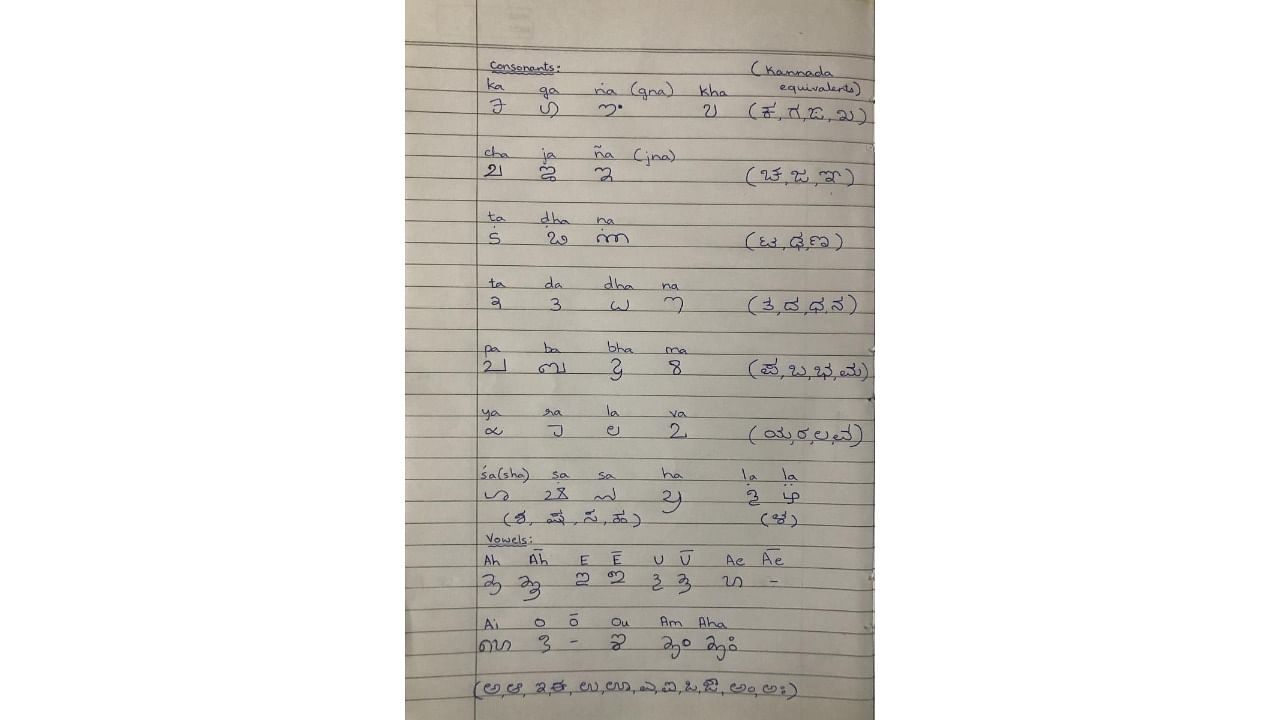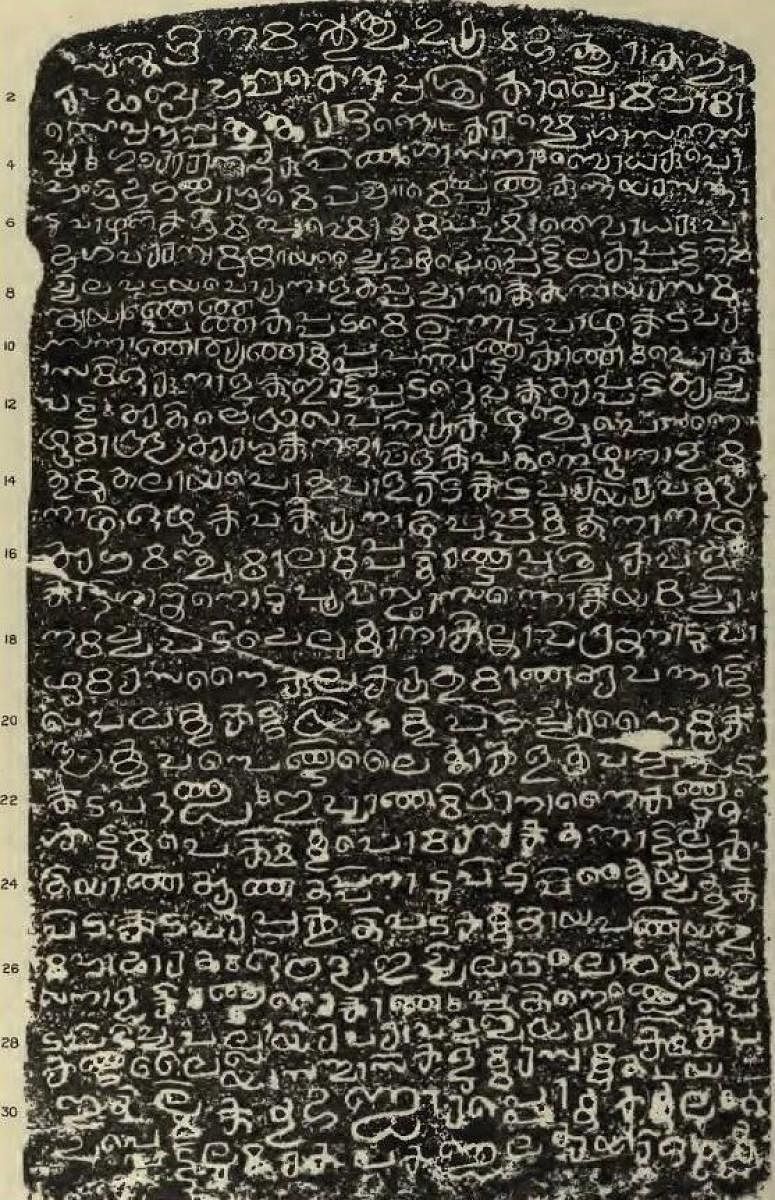

In his 1914 revised Coorg Inscriptions volume of the Epigraphia Carnatica book series, B L Rice has listed two peculiar 14th century inscriptions, which were dismissed as a mixture of scripts and languages. But it beats logic for an inscription to use a mixture of languages.
Studying the inscription, I have managed to separate the characters and group them into an alphabet, which is halfway between an intermediate transitional Grantha script and the Tulu-Tigalari script, related to the 14th century Tamil letters.
Since the two inscriptions were found in two prominent temples of Kodagu, I prefer to call the script ‘Thirke’, after the Kodava word for a temple. An online organisation called ‘Indian Roots Polyglots’ calls the script “Old Kodava script”.
Narasimhachar, one of the scholars who helped decipher the inscriptions for Rice noted that the characters “are a jumble of ‘Grantha, Malayalam, Tamil and a few Vatteluttu. There is no doubt about portions being in Tamil, but other portions are in a language which is neither Malayalam nor Tulu but is related to them. I think the inscriptions are older than 1400 AD. Some of the characters appear to go back to the 11th century.”
The Kodava language is the descendant of the Tamil-Kodagu branch of the Dravidian language family. Tamil-Kodagu is older than Tamil-Malayalam, the parent of the Malayalam language.
The Brahmi script was used all over ancient India but its variants were used in South India. There were the Kadamba and the Pallava scripts, named after ruling dynasties of their ages.
The Kadamba script gave rise to the Kannada and the Telugu scripts. The Pallava script gave rise to Tamil and Grantha. These in turn were related to the Vatteluttu and the Tulu-Tigalari scripts. The Tulu-Tigalari script itself is a descendant of the Grantha script.
However, neither is the Thirke (or Old Kodava) script itself modern Tulu-Tigalari nor is the language used modern Kodava. The Kodava and the Tamil languages don’t have long consonants, unlike most other Indian languages. But the Old Kodava script itself has a few long consonants. We can safely say that the language used is a lost language which was an ancestor of or at least related to the modern Kodava language.
Like in the Tulu-Tigalari and other related scripts, some letters in this Thirke (Old Kodava) alphabet (such as cha, pa and va) are like each other and maybe mistaken for each other. Ta and da are interchangeable in this script, like in Old Malayalam. Hence, Nadu is sometimes called Natu in the two inscriptions.
Meanwhile, in the palace garden of the Heggade rulers of Vitla is a stone pot with an inscription. P Gururaj Bhat had claimed that the script was Tulu and the language Kodava. The script used is not the same as the one used in the two 14th century inscriptions of Kodagu. Recently, it has been found that the Vitla palace inscription actually uses the Malayalam script and language.
The earliest inscriptions found in Kodagu date back to the 9th and 10th centuries and are in Kannada.
A stone inscription from 888 AD found in Biliyur village mentions a Kadanga, a defensive earthwork barricade against enemy soldiers and elephants unique to Kodagu and made by the Kodavas. The same inscription, along with a few later ones, mentions the Entu Okkal or the eight householder families, who held some power in the region. An Okkal is a land-owning agriculturist family. It corresponds to the Kodava word Okka.
These eight families could correspond to the eight sime thakkas (regional chieftain families) of Kodagu – eight hereditary chieftain families (Kallera, Bollera, Pardanda, Pandira, Mathanda, Buduvanda, Porera and Paruvanda).
The two 14th century inscriptions of Kodagu are dated around 1370-1371 AD. Both state that the king or overlord is Bodharoopa Bhagavar who issued the two edicts. The Bhagamandala inscription mentions that the ruler of that nad (region) is Melpundi Kunniyarasa. The name Kunniyarasa means ‘little ruler’.
The two inscriptions were found in the Bhagandeshwara temple of Bhagamandala and the Mahalingeshwara temple of Palur. Both temples are Shaiva temples. Both the inscriptions begin with the Sanskrit words Svasti Sri, which mean ‘Be it well’. This is similar in meaning to the term “Baalo” with which most Kodava folksongs begin.
The Bhagamandala edict goes as follows. On a Friday, when Jupiter was in Virgo, during the month of Scorpio, the Bhagamandala inscription is created. A penalty is stated for stopping the daily expenses. Even the ruler Kunniyarasa is not spared of this penalty. Curses are placed upon those who don’t pay for the daily expenses of the temple. Even if the king doesn’t punish one who doesn’t pay, he is to be cursed by the people. The ‘arm-bearing thousands’ (soldiers) of the 18 regions and merchants are to protect the temple. Blessings are pronounced upon the ascetics and the king. A mention of a copper plate and a treasury register (both of which went missing over the centuries) is also made.
The Palur edict begins with a prayer to Vinayaka (Ganesh) and Saraswathi. Bodharoopa is mentioned to be the disciple of a particular guru and to have made the stone inscription to the Mahadeva (Shiva) of Palayur. A curse is pronounced upon those who don’t pay for the daily expenses. The edict is made for the Srivaishnava, the merchants, the arm-bearing thousands, and the Brahmans of the 18 regions who may see and maintain it. The merchants will read out loudly the daily expenses once a year and check the temple accounts. This edict is unsigned, unlike the Bhagamandala one.
Srivaishnava was a general South Indian term for people who rendered services to a temple, such as guarding it, being the torchbearer (like the mukkati families in Kodagu), managing its festive activities, (like the deva thakka families in Kodagu), etc.,
Palur is called Palayur while Bhagamandala is also called Bhaganda Ashrama and Vaganda in the two inscriptions. The Bhagamandala inscription has been signed as Pakandala Ayari elattu (translated as “the writing of the Bhagandalaya Achari”). Pakandala and Bhagandalaya are other names for Bhagamandala. The modern Kodava word for writing is elt, which could have arisen from the word ‘elattu’.
Achari is a name used by priests and members of the Vishwakarma community. People of the Vishwakarma community served as metal, stone, and wood workers such as carpenters, smiths, and stone masons. Usually, a carpenter or a foreman was called an Achari.
It is interesting to note that Kodagu has a community of Kodava speaking smiths called the Airi. The word Ayari seems to indicate that the word Airi rose from the term Achari. Hence, the title Pakandala Ayari could simply mean, the ‘Airi from Bhagamandala’
(The author is a history enthusiast)